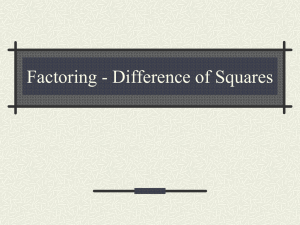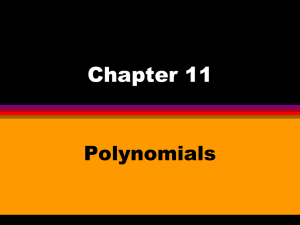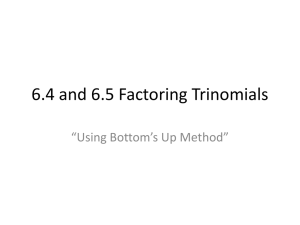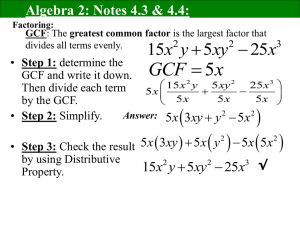5.4 Factoring
advertisement
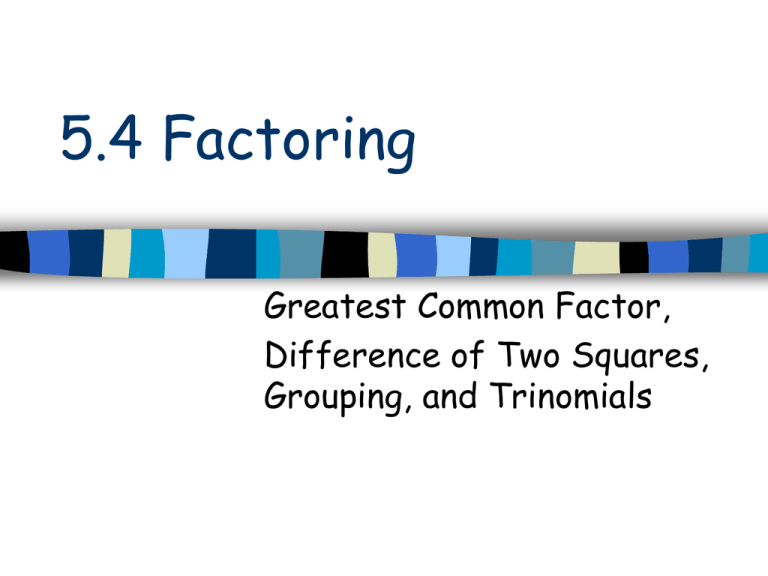
5.4 Factoring Greatest Common Factor, Difference of Two Squares, Grouping, and Trinomials Factoring a polynomial means expressing it as a product of other polynomials. Factoring Method #1 Factoring polynomials with a common monomial factor (using GCF). **Always look for a GCF before using any other factoring method. Steps: 1. Find the greatest common factor (GCF) • Look for the number GCF, then look for variables in common. The lowest exponent of each variable in common will be part of the GCF. 2. Divide the polynomial by the GCF. The quotient is the other factor. 3. Express the polynomial as the product of the quotient and GCF. 3 2 2 Ex: 6c d 12c d 3cd GCF 3cd STEP #1: Step#2: Divide 3 2 2 (6c d 12c d 3cd) 3cd 2 2c 4cd 1 The answer should look like this: 3 2 2 Ex: 6c d 12c d 3cd 2 3cd(2c 4cd 1) Factor these on your own looking for a GCF. 1. 6x 3x 12x 3x2x 3 2 2. 5x 10x 35 5x 2 2 2 x 4 2x 7 3. 16x y z 8x y z 12xy z 3 4 2 2 3 3 2 4xy z4x y 2xz 3yz 2 2 2 2 Factoring Method #2 Factoring polynomials that are a difference of perfect squares. • DIFFERENCE OF PERFECT SQUARES When factoring using a difference of squares, look for the following 3 things: 1. Only 2 terms 2. Minus sign between them 3. Both terms must be perfect squares • If all 3 of the above are true, write 2 ( ), one with a + sign and one with a – sign ( + ) ( - ) The terms in each of the parentheses will be the square root of each term. A “Difference of Perfect Squares” is a binomial (*for 2 terms only*) and it factors like this: 2 2 a b (a b)(a b) To factor, express each term as a square of a monomial then apply 2 2 the rule... a b (a b)(a b) 2 Ex: x 16 2 2 x 4 (x 4)( x 4) Here is another example: 1 2 x 81 49 2 1 2 1 1 x 9 x 9 x 9 7 7 7 Try these on your own: 1. x 121 x 11x 11 2. 9y 169x 2 2 2 3y 13x 3y 13x 3. x 16 x 2x 2x2 4 Be careful! 4 Factoring Method #3: Factor By Grouping FACTOR BY GROUPING 1. When polynomials contain four terms, it is sometimes easier to group terms in order to factor. 2. Your goal is to create a common factor. 3. You can also move terms around in the polynomial to create a common factor. 4. Practice makes it easier to recognize common factors. Factoring By Grouping 1. Group the first two terms and the last two terms by putting parentheses around them. 2. Factor out the GCF from each group so that both sets of parentheses contain the same factors. 3. Factor our GCF again and write the answer as the product of two binomials. Ex: b 3 2 3b 4b 12 Step 1: Group b 3b 4b 12 3 2 Step 2: Factor out GCF from each group b b 3 4b 3 2 Step 3: Factor out GCF again b 3b 4 2 3 2 2x 16x 8x 64 Ex2 3 2 : 2 x 8x 4x 32 2x 8x 4x 32 2x x 8 4x 8 2x 8x 4 3 2 2 2 2x 8x 2x 2 Factoring Chart This chart will help you to determine which method of factoring to use. Type Number of Terms 1. 2. 3. 4. GCF Diff. Of Squares Trinomials Grouping 2 or more 2 3 4 Box Method 1. Make a box with four squares 2. Make sure that the terms of the trinomial are in descending order. 3. Put the first term in the top left box. 4. Put the last term in the bottom right box. 5. Multiply those two terms together. 6. List factors of the product in #5 that will add together to get the middle term. 7. Put those in the other two boxes. 8. Find the GCF of each row and column – that is your trinomial factored. Only take out a negative if the first box in the row or column is a negative number. Trinomials x 7x 6 2 Trinomials 2a 3a 1 2 Trinomials 6c 13c 6 2 Trinomials 12m m 6 2 1) Factor 2x2 + 9x + 10 (x + 2)(2x + 5) 2) Factor 2 6y - 13y - 5 (2y - 5)(3y + 1) 3) 2 12x + 11x - 5 (4x + 5)(3x - 1) 4) 5x - 6 + 2 x x2 + 5x - 6 (x - 1)(x + 6)




